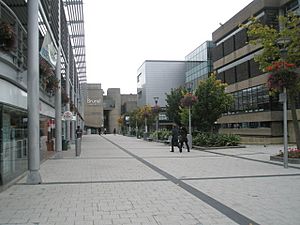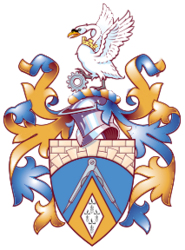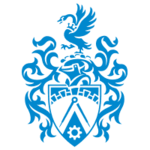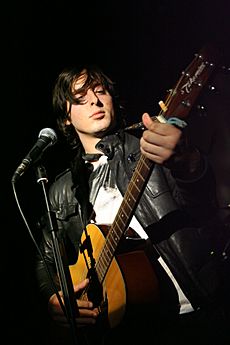Brunel University of London facts for kids
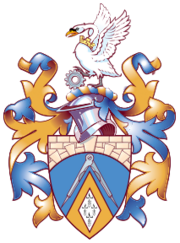
|
|
| Type | Public |
|---|---|
| Established | 1966 – gained university status by royal charter |
|
Parent institution
|
University of London (Joined the federation in 2024) |
| Endowment | £1.57 million (2022) |
| Budget | £271.3 million (2021–22) |
| Vice-Chancellor | Andrew Jones |
| Rector | Jocelyn Bell Burnell |
| Students | (2015/16) |
| Undergraduates | (2015/16) |
| Postgraduates | (2015/16) |
| 974 | |
| Address |
Kingston Lane, Uxbridge UB8 3PH
,
England, United Kingdom
51°31′58″N 0°28′22″W / 51.53278°N 0.47278°W |
| Campus | Suburban |
| Precursor institutions | Borough Road College (est 1798) Maria Grey College (1878) Shoreditch College of Education (1902) Acton Technical College (1928) Brunel College of Advanced Technology (1962) |
| Colours | Blue and gold |
| Affiliations | Association of Commonwealth Universities European University Association |
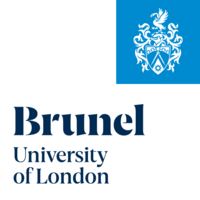 |
|
Brunel University London (BUL) is a public research university in the Uxbridge area of London, England. It is named after the famous Victorian engineer Isambard Kingdom Brunel, who was a key figure in the Industrial Revolution.
The school officially became a university in June 1966. This happened when it was given a royal charter, which is a special document from the monarch that grants new powers or rights. Because it was founded in the 1960s, it is sometimes called a plate glass university, a name for a group of universities created around that time.
In 2024, Brunel University London became a member of the famous University of London. The university is split into three main colleges: the College of Business, Arts and Social Sciences; the College of Engineering, Design and Physical Sciences; and the College of Health, Medicine and Life Sciences.
Brunel has more than 16,000 students and over 2,200 staff members. It is known for its strong focus on engineering and technology, but it also offers many courses in the arts, sciences, and humanities.
Contents
History
How the University Began
Brunel University London is one of several British universities that started in the 1960s. The government wanted more people to have the chance to go to university.
Its story begins with Acton Technical College, which opened in 1928. In 1957, the part of the college for more advanced studies was renamed Brunel College. It was named after the great engineer Isambard Kingdom Brunel.
In 1962, the college was given a higher status, and a new campus was planned in Uxbridge. The buildings were designed in a style called Brutalism, which uses a lot of concrete and has a bold, blocky look.
Becoming a University
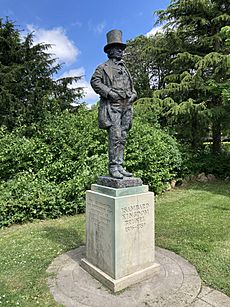
On June 9, 1966, Brunel College was granted a royal charter and officially became Brunel University. This meant it could award its own degrees to students.
Over the years, the university grew by joining with other colleges. In 1980, it merged with Shoreditch College of Education. In 1995, it joined with the West London Institute of Higher Education. This added new subjects like arts, humanities, and sports science to the university.
In 2014, the university officially changed its name to Brunel University London. It celebrated its 50th anniversary in 2016 with many special events. In October 2024, it became a member of the prestigious University of London.
The University Campus
In the late 1990s, Brunel started a 10-year plan to improve its campus. The university spent £250 million to update its buildings and facilities in Uxbridge. This included a bigger library, a modern sports complex, and new student housing.
Many of the buildings on campus have a unique 1960s Brutalist style. Because of its distinct look, the campus has been used as a filming location for movies and TV shows. It was famously featured in Stanley Kubrick's film A Clockwork Orange. It has also appeared in British TV shows like Spooks and Inspector Morse.
Organisation and Subjects
Colleges
Brunel is organised into three main colleges, which are like big departments. Each college focuses on different subjects.
- College of Engineering, Design and Physical Sciences: This college includes subjects like Computer Science, Engineering, and Mathematics.
- College of Business, Arts and Social Sciences: This college covers areas like Business, Law, Education, and Arts.
- College of Health, Medicine and Life Sciences: This college is for students studying subjects like Medicine and Life Sciences.
Coat of Arms
The university was granted a coat of arms in 1970. It is a special symbol that represents the university's history and values.
- The stone arch represents Isambard Kingdom Brunel.
- The compass and cogwheel stand for technology.
- The swan on top is a symbol for Uxbridge, the university's location.
In 2024, when Brunel joined the University of London, the coat of arms was updated slightly for a new logo.
Academic Life
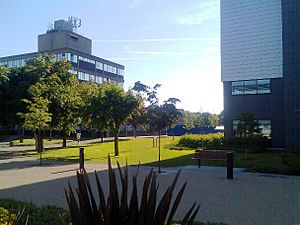
Brunel is known for its focus on practical experience. Many students can take part in work placements as part of their degree. This is often called a sandwich degree because a year of work is "sandwiched" between years of study.
The university has many special facilities for students. These include science labs, flight and driving simulators, a 3-D body scanner, and an MRI scanner.
'Made in Brunel'
Every year, the university's Design School holds a special exhibition called 'Made in Brunel'. It showcases the amazing projects created by final-year design and engineering students. The event is held in central London to show the students' work to people in the design industry.
Student Life
Facilities and Fun
Brunel's campus has a lot to offer students. There is a gym, a spa, and a running track. There is also a pharmacy, a shop, a bar, a nightclub, and a café.
In the past, the university was a popular place for bands to perform. Famous groups like Fleetwood Mac, The Who, and Genesis all played at Brunel.
The university library is in the Bannerman Centre and is usually open 24/7 during term time. It has around 400,000 books and 1,500 places for students to study.
Union of Brunel Students
The Union of Brunel Students is an organisation run by students, for students. It represents the interests of students and runs services on campus, including a nightclub and a bar. The Union is led by students who are elected each year.
Student Housing
Brunel has 34 student halls on campus, with over 4,500 rooms. Living on campus is a great way for new students to make friends and be close to their classes.
Many of the halls are named after famous engineers, scientists, or the bridges designed by Isambard Kingdom Brunel. For example:
- Clifton Hall (named after the Clifton Suspension Bridge)
- Saltash Hall (named after the Royal Albert Bridge)
- Fleming Hall (named after Alexander Fleming, who discovered penicillin)
- Faraday Hall (named after the scientist Michael Faraday)
Notable People
Many famous people have studied or taught at Brunel University.
Famous Teachers
- Bernardine Evaristo: A professor and author who won the famous Booker Prize in 2019.
- Will Self: A well-known author and Professor of Modern Thought.
- Benjamin Zephaniah: Was a popular poet and Professor of Creative Writing.
Famous Graduates
Brunel alumni have become successful in many different fields, from entertainment to politics and sports.
Media and Arts
- Jo Brand: A popular comedian and actress.
- Greg Davies: An actor and comedian known for shows like The Inbetweeners and Taskmaster.
- Lee Mack: A famous comedian and TV personality.
- Archie Panjabi: An actress who won an Emmy Award for her role in the TV show The Good Wife.
- Carl Barât: A musician and singer for the bands The Libertines and Dirty Pretty Things.
Politics
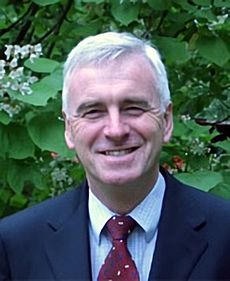
- Guillaume, Hereditary Grand Duke of Luxembourg: The future head of state of Luxembourg.
- John McDonnell: A British politician who served as Shadow Chancellor of the Exchequer.
- Rosena Allin-Khan: A doctor and politician in the Labour Party.
Sports
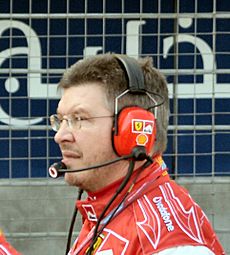
- Tony Adams: A former captain of Arsenal and the England football team.
- James Cracknell: A rower who has won two Olympic gold medals.
- Audley Harrison: A boxer who won an Olympic gold medal.
- Richard Hill: A rugby player who was part of the England team that won the 2003 Rugby World Cup.
- Ross Brawn: An engineer who has been a manager for several Formula One teams, including Mercedes and Ferrari.
See also
 In Spanish: Universidad Brunel para niños
In Spanish: Universidad Brunel para niños
- Armorial of UK universities
- College of advanced technology (United Kingdom)
- List of universities in the United Kingdom
- Universities in London


